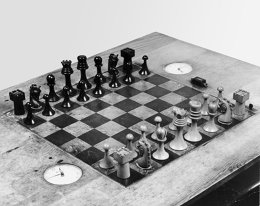Artist and sculptor Marcel Duchamp might be most famous for his Modernist painting Nude Descending A Staircase, No. 2, but his true passion may have been chess. After retiring to pursue an almost monk-like dedication to the game, he described himself as a "victim of chess. It has all the beauty of art--and much more."

But Duchamp did not entirely abandon art: He designed two chess sets. The second was a simple pocket chess set he designed in 1943. Featuring a simple set of plastic pins that slide into a slotted vinyl board, Duchamp meant for it to be mass-produced. Instead, it was only ever released as a limited edition; One of the only known copies is on display at the Philadelphia Museum of Art. As for the first set, it has been lost for nearly a century. Until now: 3-D printers have brought it to life.
Carved by hand in 1918 in Buenos Aires, the Duchamp Chess Set, as it is known, is a sumptuous Art Deco affair. The design has intrigued both chess players and art aficionados for decades. Seemingly inspired by the Staunton chess set, Duchamp's design visually imparts a sense of weight and even agility to individual pieces: The rook is heavy, cubist, and stalwart, and the knight possesses the the sinuous spiral of a darting sea horse. It's a beautiful set.

Although it is rumored to still exist in a private collection, no one has seen it in person: The set has existed, for the better part of a century, in just a few photographs. But in recent years, some have attempted to recreate the Duchamp Chess Set digitally.
In 2010, Scott Kildall created an app that aimed to recreate Duchamp's style of chess play. As a bonus, the app included a 3-D recreation of the Duchamp set. But that wasn't enough for Kildall. He wanted to play with the Duchamp set in real life. He wanted to feel the mane of the knight beneath his fingers, the heft of the rook as it got picked off the board.
To make a physical Duchamp set a reality, Kildall teamed up with modeler and maker Bryan Cera to take the existing photographs of the original set, scan it to extrapolate the geometry, and then transform it into a 3-D model that could be printed out on any MakerBot.
The knight proved the hardest to model. In chess, knights tend to be the most elaborately detailed pieces, and are often carved with distinct sets of teeth and flowing manes. Since the only existing photograph of the Duchamp Chess Set is both low-contrast and low-resolution, Cera couldn't see the detail close enough to model it. He solved the problem, in part, by running a series of geometry-extrapolating algorithms on the photograph. But he didn't achieve full fidelity until Cera discovered that there was another photo of the knight out there, this time as part of a 1967 work by Duchamp titled Marcel Duchamp moulé vif. By comparing the two photographs, Cera was finally able to solve the riddle of Duchamp's knight design.

Kildall and Cera call the process they used to recreate the Duchamp Chess Set "Readymake." It's a semi-tongue-in-cheek reference to the ready-made school of Modernism, originated by Duchamp, in which unaltered objects that were not originally designed as art are presented as such. Similarly, the Duchamp Chess Set is a found object, lost in the filing cabinets of photographic history. It is only now, thanks to its resurrection, that it is capable of being art.
But the Readymake concept could be much bigger than just the recreation of one chess set. It hints at the boldly versatile future of 3-D printing, in which art, even fine art, is profoundly affordable. Artists will be able to develop mass audiences for their sculptures just by uploading them to the Internet. And the fact that the Readymake concept begins with Duchamp's Chess Set seems particularly appropriate. To Duchamp, chess and art were indistinguishable from one another in the quality of their beauty. Whether by designing an affordable pocket chess set, or placing a fountain on a pedestal as a ready-made object, he wanted chess and art to be for everyone.
Now, thanks to 3-D printing and some digital archeology, they are. The only irony is that it was the chess set that Duchamp never meant to be mass-produced that is now being printed out by hundreds of makers around the world--while the one he did sits in a museum display case, collecting dust.
[H/T Greg.org]